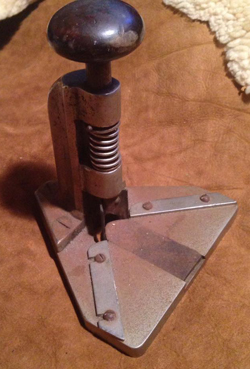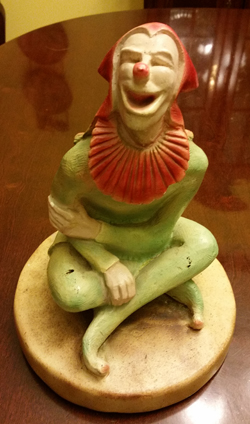 |
|
|||
 |
 |
|||
Copyright © Harry Rinker, LLC 2016 Questions
and Answers
QUESTION: I found a Will & Finck of San Francisco ANSWER: Frederick Adolph Will (1837 to 1912) and Julius Finck (1831 to 1914) formed a partnership in 1864 to produce knives and other cutting devices. A Will & Finck bowie knife was a shooting prize at a police event in in 1864. Will & Finck acquired Frederick Kesmodel, another cutlery firm, in 1867. By 1868, the firm was producing gambling products, including a steel box for card dealing, along with bowie knives, carving knives, dirks, and forks. Will & Finck also sold items imported from New York and foreign manufacturers. When the cutlery business declined in the 1880s, the company increased its manufacture of other products, including gambling equipment. Your device is known as a round-corner cutter and is used in conjunction with a card trimmer to alter a deck of cards. A round-corner cutter and card trimmer are two separate devices. The website http://sharpsandflats.com/prepared_cards_03.html reprints John Nevil Maskelyne’s 1894 classic “Sharps and Flats: A Complete Revelation of The Secrets of Cheating at Games of Chance and Skill.” The introduction notes: “At the time crooked gambling supply houses (also called ‘sporting houses’) flourished. These were companies that sold crooked gambling supplies and cheating equipment through mail order catalogs. One of the most infamous crooked gambling suppliers of the time was Will and Finck. It is from the Will and Finck mail order catalog where Maskelyne obtained most of the illustrations in his book; and used them without credit or clearance.” Chapter IX “Prepared Cards” includes this information: “Square-cornered playing-cards of course will show no signs of having been trimmed in this way; but those with rounded corners are bound to do so, however slight a shaving may have been removed from the side. In trimming these for cheating, therefore, the sharp has to employ, in addition to the shears, what is called a ‘round-corner cutter.’ This is an instrument which restores the circular form of the corners, which otherwise would show the point at which the shears cut through them. It is simply a sort of punch, which cuts the corners, one at a time, into their original shape, and gives them the proper curve.” Your round-corner cutter is identical to one produced by George Mason & Co. of Chicago. It is possible that Will & Finck purchased examples from this firm and substituted their name plate prior to selling them. There is strong collector interest in early gambling material. The interest extends to modern card cheats (sharps) since the older devices are as useable today as they were when they were first made. Modern business equipment corner-rounder cutters retail for around $150.00, although it is possible to buy a Martha Stewart Crafts-rounder for $6.99. The asking price for a late 19th / early 20th century Will & Finck card trimmer often exceeds $1,000.00. Antique corner-rounder cutters are valued between $350.00 and $450.00. QUESTION: My Aunt Mary Sullivan owned a chalkware ANSWER: ESCO Products, Inc. produced a variety of chalkware figures, the most collected being those of famous movie, music, and television personalities from the mid-1960s to the 1990s. Having found many different artists listed in the copyrights on the bottom of ESCO Product, Inc., figures, it appears Vilis Berzins was one of several designers used by the company. Since collector interest is strongest in the personality figures, most information found on the internet relates to them. The following summary is from information found on: http://www.atlasobscura.com/articles/where-those-bigheaded-statues-in-smoky-80s-bars-came-from?utm_source=facebook.com&utm_medium=atlas-page. ESCO stands for Entertainment Statue Company, a later incarnation of ESCO Products, Inc. Although speculation is that the company started in the early 1970s, your chalkware piece suggests a mid-1960s date. ESCO’s location is subject to debate. Most surmise it was based in New Jersey. An individual who claimed to have known the owner posted on an internet forum that the company was located at 59th Street in Brooklyn’s Borough Park. There are several internet forums and repair sites devoted to ESCO personality figures. One person claims to have compiled a list of more than 85 different figures. A quick checklist based on examples for sale on the internet includes: Muhammad Ali, Louis Armstrong, Milton Berle, The Beatles, Jack Benny, Humphrey Bogart, Bozo the Clown, Lou Costello, Bing Crosby, Dr. Jekyll and Mr. Hyde, Jimmy Durante, Elvis, W. C. Fields, Clark Gable, The Honeymooners (separate figures), Bob Hope, Green Hornet and Kato (separate figures), Boris Karloff’s Frankenstein, Bella Lugosi’s Dracula, Laurel and Hardy (separate figures), Rocky Marciano, Dean Martin, Groucho Marx, Harpo Marx, Gregory Peck, General Rommel, Babe Ruth, Frank Sinatra, Bruce Springsteen, James Stewart, The Three Stooges (separate figures), and John Wayne. [AUTHOR’S ASIDE: With the exception of the female figures from the Honeymooners, the balance of the list is male. I am not certain what this means, but it seems significant.] ESCO figures were sold in curio shops. Many appeared as decoration in bars and restaurants. ESCO continued to make figures into the 1990s, including Bill Clinton holding a sax. New owners purchased ESCO in the early 2000s. The company, a division of ODM, Inc., is based in Canton, Ohio. Today’s products are made from resin, hand polished, and painted. The secondary market for non-personality ESCO figurines is weak. Although your figurine is a court jester and not a clown, it suffers from the collapse of the secondary market for clown related merchandise. Your jester figurine is worth between $17.50 and $22.50. QUESTION: Years ago when my parents were antiquing in the Chicago area, they purchased a copy of the April 18, 1912 edition of “The Republic,” a St. Louis newspaper published by George Knapp & Co., the headline reading “1475 Lost in Titanic Disaster.” The paper has a mailing label addressed to Effie Reavis, Rardin, Illinois, on it. The paper is framed and in excellent condition. What is its value? – JS, Email Question ANSWER: You have a “headline” newspaper. The value of headline newspapers depends on location. Normally, the headline newspaper from the location closest to the disaster is the most desirable, for example, the “New York Times” for the sinking of the “Titanic” or the “Dallas Morning News” for the Kennedy assassination. Timothy Hughes (www.rarenewspapers.com), a major dealer in rare and early newspapers, lists a number of “sinking of the Titanic” headline newspapers. Examples in very good and better condition outside the New York market are priced between $175.00 and $200.00. Take a conservative approach in valuing your example. Think $125.00 to $150.00. These are retail prices. If selling expect to receive between 30 and 50 percent of these prices. QUESTION: I have a Huffy bicycle. A label on it reads: BMA/6. What is its value? – H, Reading, PA ANSWER: I cannot answer your question. I have a Huffy Bicycle is like stating I have a car. What car, what model, what year, what condition – the list of questions to be answered before determining value is endless. I can tell you about the “BMA/6” label. This is not a model number. It is a certification label created in the early 1970s. The Consumer Products Safety Commission took Bicycle Manufacturer’s Association standards and attempted to apply them to children’s bicycles. High-end manufacturers such as Schwinn refused to participate. In reality, manufacturers such as Huffy were relatively free to set their own standards. One forum blogger commented: “When I worked at the bike shop, BMA 6 was synonymous for “crappy POS bicycle.” [I leave it to my readers to figure out what POS means.] Collector interest in 1970s Huffy bikes is minimal at the moment. Values on eBay range from $30.00 up to $300.00 depending on the model. These prices appear aimed at the buyers who want to buy back their childhood bike as opposed to collectors. Most Bloggers suggest selling Huffy bikes for scrap. The metal content is worth between $2.00 and $5.00.Harry L. Rinker welcomes questions from readers about
collectibles, those mass-produced items from the twentieth and twenty-first centuries.
Selected letters will be answered in this column.
Harry cannot provide personal answers.
Photos and other material submitted cannot be
returned.
Send your questions to: Rinker on Collectibles, 5955 Mill
Point Court SE, Kentwood, MI 49512.
You also can e-mail your questions to
harrylrinker@aol.com.
Only e-mails containing a full name and mailing address
will be considered.
You can listen
and participate in
WHATCHA GOT?, Harry’s
antiques and collectibles radio call-in show, on Sunday mornings between 8:00 AM
and 10:00 AM Eastern Time.
If you
cannot find it on a station in your area,
WHATCHA GOT?
streams live on the Internet at www.gcnlive.com.
SELL, KEEP OR TOSS?: HOW TO DOWNSIZE A HOME,
SETTLE AN ESTATE, AND APPRAISE PERSONAL PROPERTY
(House of Collectibles, an imprint of Random House Information Group, $17.99),
Harry’s latest book, is available at your favorite bookstore and via
www.harryrinker.com.
|
||||
 card cutter in a thrift shop in the mountains of North Carolina. A card trimmer is used to alter a deck of cards if the corners are bent but also can be used to trim cards in order to cheat. The card trimmer is in fine shape and works like it was brand new. I would love to know more information about this item and its value. – CW, Email Question.
card cutter in a thrift shop in the mountains of North Carolina. A card trimmer is used to alter a deck of cards if the corners are bent but also can be used to trim cards in order to cheat. The card trimmer is in fine shape and works like it was brand new. I would love to know more information about this item and its value. – CW, Email Question. seated jester figure. It was marked on the bottom: “COPYRIGHT © 1966 / BY VILIS BERZINS / ALL RIGHTS RESERVED.” What can you tell me about it? – RS, Berks Co., PA, Email Question
seated jester figure. It was marked on the bottom: “COPYRIGHT © 1966 / BY VILIS BERZINS / ALL RIGHTS RESERVED.” What can you tell me about it? – RS, Berks Co., PA, Email Question